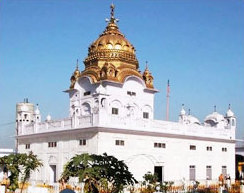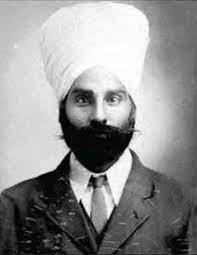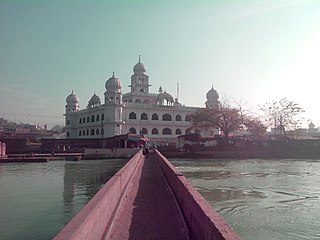See also
Name list
This page or section lists people that share the same given name. If an internal link led you here, you may wish to change that link to point directly to the intended article.
Jiwan may refer to:

Kaviyo Bach Benti Chaupai is a hymn by Guru Gobind Singh. Chaupai is the 405th Charitar of the Charitropakhyan composition contained within the Dasam Granth. It forms part of a Sikh's Nitnem and is read during Amrit Sanchar ceremonies.
Raja Sukh Jiwan Mal was the Raja of Kashmir from 1754 to 1762. He rose from the rank of soldier to governor and then finally became a ruler. He was the last independent monarch of Kashmir.

Nawab Kapur Singh was a major Sikh leader who led the community during the early-to-mid 18th century. He was the organizer of the Sikh Confederacy and its military force, the Dal Khalsa. He is held in high regards by Sikhs.
Randhawa is a Jat clan found in the Punjab region of India and Pakistan. The Randhawa name has special significance in the history of the Sikh faith, the first appointed Granthi was a Randhawa There are also adherents of Hinduism and Islam belonging to the Randhawa clan.

Dera Baba Nanak is a town and a municipal council in Gurdaspur district, in the state of Punjab, India. It is the sub-district headquarters of Dera Baba Nanak tehsil. It is 36 km away from Gurdaspur city, the capital of the district. Since November 2019, a corridor between India and Pakistan has been established at its shrine.
Raikot is a city and municipal council in Ludhiana district in Indian state of Punjab. Raikot is one of the tehsils in Ludhiana district of Punjab. there are total 76 villages in this tehsil.
Rania is a town and a municipal committee in Sirsa district located on the upper bank of Ghaggar River in the Indian state of Haryana. Rania Town is a grain market in Sirsa district. Nearby cities to Rania includes Sirsa and Ellenabad. It shares its RTO office with Ellenabad which is also has its headquarters in Ellenabad. Earlier it was a part of Ellenabad subdivision but later carved out separately as a subdivision in Sirsa district of Haryana. It is at a distance of 22 km each from Sirsa and Ellenabad in opposite direction on Haryana State Highway 32A i.e. Bhambhoor-Jiwan Nagar Road which connects to Haryana State Highway 32 in Jiwan Nagar on one end and Haryana State Highway 23 in Bhambhoor on the other end.

Karam Singh (1884–1930) was a Sikh historian. He was born in Jhabal a town 8 kilometres (5 mi) south of Amritsar. His father Jhanda Singh belonged to traditional Sikh family.

Baba Jiwan Singh was a Sikh general and companion of Guru Gobind Singh.

Kiratpur, also known as Kiratpur Sahib, is a town, just 30 km from Rupnagar city in Rupnagar district of Punjab, India. The town is the location of the Gurdwara Patal Puri where many Sikhs take ashes of their deceased.

Akali Phula Singh Nihang was an Akali Nihang Sikh leader. He was a saint soldier of the Khalsa Shaheedan Misl and head of the Budha Dal in the early 19th century. He was also a senior general in the Sikh Khalsa Army and commander of the irregular Nihang of the army. He played a role in uniting Sikh misls in Amritsar. He was not afraid of the British who at many times ordered for his arrest but were not successful. During his later years he served for the Sikh Empire as a direct adviser to Maharaja Ranjit Singh. He remained an army general in many famous Sikh battles up until his martyrdom in the battle of Nowshera. He was admired by the local people and had a great influence over the land and his settlement was always open to help the poor and helpless. He was well known and was a humble unique leader and prestigious warrior with high character. He was also known for his effort to maintain the values of Gurmat and the Khalsa panth.
Jiwan Singh Umranangal (1914-1998) was an Indian politician belonging to the Akali Dal. He served as the revenue minister of Punjab.

Binod Singh, a Trehan Khatri and a descendant of Guru Angad, was an army man and disciple of Guru Gobind Singh and was among few Sikhs who accompanied him to Nanded in 1706. In Budha Dal Chronicles, Guru Gobind Singh made Baba Binod Singh the head of the Khalsa.

Baba Baj Singh, also known as Baj Bahadur, was a Sikh general, governor, scholar and martyr from present-day India.

The Battle of Gurdas Nangal took place in April 1715 between the Sikhs, led by Banda Singh Bahadur, and the Mughal Army, led by Abd al-Samad Khan. Banda, at that time was carrying out operations and small raids to the north of Amritsar. During these operations, the Mughal Army confronted the Sikhs. When confronted, the Sikhs moved northward taking shelter in the fort of Gurdaspur. It had been recently extended to accommodate 60,000 horses, and stores of food, grain and fodder had also been collected there. The Mughal Army converged upon the fort from three sides. The Delhi force of 20,000 men under Qamar-ud-din Khan advanced from the east. The Governor of Lahore’s troops, consisting of 10,000 men under Abd al-Samad Khan, marched from the south. Finally, Jammu troops numbering nearly 5,000, under Zakariya Khan, approached from the north. To the west of the fort was the River Ravi, which had no bridge over it. All the boats had been withdrawn to the opposite bank, which was closely guarded by numerous local chiefs and Mughal government officials. The Mughal pursuit made it so the Sikhs could not enter the fort at Gurdaspur. Thus, the Sikh army quickly turned west.
Nangal is a small village near Nihal Singh Wala Tehsil in the Moga district of Punjab, India. This small village had a population of nearly 2500 according to the 2011 census.

Baba Buddha was a prime figure in early Sikhism.

Gurbaksh Singh Kanhaiya was the eldest son and heir of Jai Singh Kanhaiya, the chief of the Kanhaiya Misl. He was the father of Maharani Mehtab Kaur and thus, the father-in-law of Maharaja Ranjit Singh, the founder of the Sikh Empire.
The First battle of Chamkaur was fought in 1702 between the Sikhs and the Mughals. It resulted in a Sikh victory and the Mughal General Sayyad Beg defecting to the Sikhs with some troops.
Sardarni Bibi Susheel Kaur also referred to as Mata Susheel Kaur was the wife of Sikh General Banda Singh Bahadur, who established the first Sikh state and the mother of his son, Ajai Singh. She was the only daughter of Maharaja Udai Singh of Chamba.